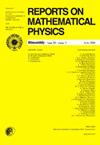平面时空基本群的非标注性
IF 1.2
4区 物理与天体物理
Q3 PHYSICS, MATHEMATICAL
引用次数: 0
摘要
本文得出,具有时间拓扑的 n 维闵科夫斯基空间的基群包含不可计数的整数加法群副本,并且不是无边际的。这一结果首先是在 n = 2 时证明的。此后,通过使用 M2 在 Mn 中的嵌入作为通过投影图的回缩,证明 M2 中的非同调环在 Mn 中继续是非同调的,从而将其扩展到 n > 2。本文章由计算机程序翻译,如有差异,请以英文原文为准。
Nonabelianness of fundamental group of flat spacetime
In the present paper, it has been obtained that the fundamental group of n-dimensional Minkowski space with the time topology contains uncountably many copies of the additive group of integers and is not abelian. The result has been first proved for n = 2. Thereafter, it is extended to n > 2 by proving that loops nonhomotopic in M2 continue to be nonhomotopic in Mn using embedding of M2 in Mn as a retract through the projection map.
求助全文
通过发布文献求助,成功后即可免费获取论文全文。
去求助
来源期刊

Reports on Mathematical Physics
物理-物理:数学物理
CiteScore
1.80
自引率
0.00%
发文量
40
审稿时长
6 months
期刊介绍:
Reports on Mathematical Physics publish papers in theoretical physics which present a rigorous mathematical approach to problems of quantum and classical mechanics and field theories, relativity and gravitation, statistical physics, thermodynamics, mathematical foundations of physical theories, etc. Preferred are papers using modern methods of functional analysis, probability theory, differential geometry, algebra and mathematical logic. Papers without direct connection with physics will not be accepted. Manuscripts should be concise, but possibly complete in presentation and discussion, to be comprehensible not only for mathematicians, but also for mathematically oriented theoretical physicists. All papers should describe original work and be written in English.
 求助内容:
求助内容: 应助结果提醒方式:
应助结果提醒方式:


